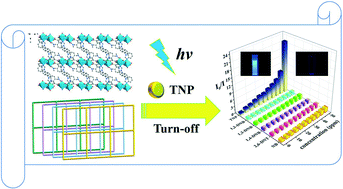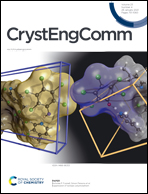2D luminescent metal–organic framework: efficient and highly selective detection of 2,4,6-trinitrophenol at the ppb level†
Abstract
A unique 2D metal–organic framework (MOF), formulated as [Cd(L)0.5(H2L1)·DMF] (CUST-531) (L: 9,10-bis(N-benzimidazolyl)-anthracene; H2L1: 5-aminoisophthalic acid), has been successfully prepared by a hybrid ligand strategy based on solvothermal synthesis conditions. CUST-531 was characterized by single X-ray diffraction, PXRD (powder X-ray diffraction), TGA (thermogravimetric analysis) and IR (infrared spectrophotometer). CUST-531 contains 1D chains based on binuclear Cd clusters, which are further connected to establish a 4-c 2D layered network by the bridging ligands L. The fluorescence sensing experiments show that the strong emission properties of CUST-531 could be used to sensitively and rapidly detect 2,4,6-trinitrophenol (TNP) at the ppb level. The fluorescence quenching mechanisms have been systematically studied through theoretical analysis and experiments, which may be the cause of the turn-off of the fluorescence signal when CUST-531 detected TNP.

- This article is part of the themed collection: Coordination Networks


 Please wait while we load your content...
Please wait while we load your content...